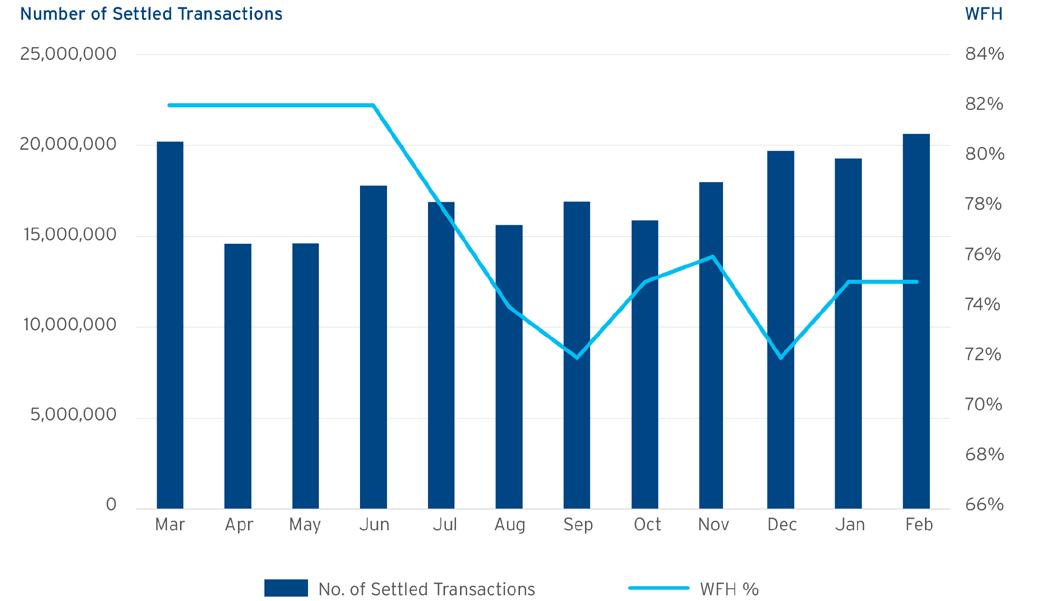
5 minute read
Embracing Change In A New World
from TNF Issue 7
COVID-19 could have been a major crisis for custodians, but this risk was avoided thanks to a combination of digitalisation, flexibility and a transformative approach towards risk management. Chay Thurlow, Global Head of Custody Operations at Citi, outlines how the securities services industry adapted to deal with COVID-19, a once in a lifetime crisis that created a perfect storm for unprecedented digitalisation.
Near real-time adoption of contingency plans
The overnight global transition to remote working forced custodians to dust off contingency plans that few thought would ever be utilised to the levels experienced over the last 12 months. The sheer scale and urgency of this transition required agility on the part of large custodians such as Citi. “The firms who were the most successful at navigating COVID-19 were the ones who learnt to adapt fast. Red tape was dramatically reduced at many institutions to facilitate the delivery of essential items like laptops and equipment to the global workforce,” said Thurlow.
ual touch points throughout the operational processes. Having a single platform also proved vital in enabling Citi to continue supporting clients during the worst of the market disruption when trading volumes eclipsed all previous records. “We have seen trading volumes increase by more than 30% in the last 12 months. However, its straight-through-processing (STP) rate was over 99% despite the widespread volatility and remote working,” said Thurlow.
Other factors also helped soften the impact of COVID-19 on clients. Citi, for example, has invested a significant amount of resources into its management information platform which tracks the lifecycle of a transaction. “Our internal metrics provides us with an overview of our clients’ intraday activity, from settlement tracking, fails management and exceptions, through to asset services and tax activities. With all this information at hand, we were able to help clients maintain business as usual during periods of volatility,” said Thurlow. The data also enabled Citi to identify and mitigate potential bottlenecks
Sweeping digitalisation enhancements are also being implemented in areas such as client on-boarding. In the immediacy of COVID-19, the rollout of digitalised client onboarding was accelerated. “The process is now supported by an electronic workflow platform where all on boarding activities will take place, and electronic signatures will be facilitated by DocuSign. Our workflow platform also features a fully digital storage system, where paperwork submitted by clients is stored and labelled centrally, eliminating the need to ever resubmit a form,” said Thurlow. Moving forward, the bank is looking to further enhance its onboarding capabilities. “Our investment in internal applications which digitize aspects of the information gathering process has allowed us to simplify and automate the on-boarding process for clients. This has resulted in the end to end process taking minutes as opposed to days,” commented Thurlow.
A new look at risk management
Risk management processes are being re-evaluated to factor in some of the changes which COVID-19 had unexpectedly forced upon the industry. Outsourcing is one area that is likely to face scrutiny, especially as a number of markets faced logistical problems during the initial shock of COVID-19. Clients will undoubtedly be reviewing the outsourcing models at their custodians in more depth once the dust settles from the pandemic. In fact, some custodians may even revisit their outsourcing arrangements – if they were found wanting - in what could potentially lead to greater in-sourcing or multi-market outsourcing. “We do not adopt an outsourcing model for custody. Instead we have embraced near-shoring and far-shoring through our Citi Solutions Centre, which operates out of Kuala Lumpur, Dublin, Warsaw, Pune and Tampa. In contrast to other custodians who have outsourced their entire back office, we leverage our Citi Solutions Centres in cost effective locations. Having ownership of this process – as opposed to being reliant on external providers - puts us in an advantageous position,” said Thurlow.
clients obtain better insights into some of the risks they are facing,” said Thurlow. “For example, we are carefully tracking client activity in order to pro-actively identify potential issues within the clients’ operations. This includes increased trade fails, delayed matching rates, late claim payments or delays in client responses. This deployment of analytics to assist in potential issue resolution earlier in the trade lifecycle has been warmly received by Citi’s clients, especially as the Central Securities Depositories Regulation (CSDR) will introduce tough penalties and mandatory buy-ins for trade settlement fails from next year,” said Thurlow.
Numerous custodians – including Citi – are also taking a step further and looking to incorporate artificial intelligence (AI) technologies into these solutions so that they can develop predictive analytics tools which can prevent settlement fails from happening altogether at clients.
Being a custodian in the new normal COVID-19 has taught custodians a number of invaluable lessons. Firstly, the industry is and remains resilient, something that is made possible by custodians being flexible and innovative during the early stages of the crisis. The industry’s willingness to digitalise core operations has also played a vital role in safeguarding market stability and improving client experiences. Many custodians are now making structural improvements to their risk management processes with a stronger focus on monitoring and analytics.
It is clear that the pandemic has had a significant impact on custody and client operations. Whether these changes become permanent remains to be seen. Nevertheless, the custodians who are willing and able to embrace change and adapt to the new normal will be ones that thrive moving forward.
A historic commitment to digitalisation also meant that Citi was exceptionally well-positioned to handle the significant trading volume spikes in March and April 2020. Thurlow highlighted that the bank had been investing in the development of its common settlement platform across its custody businesses since 2019. This allowed for widespread efficiencies and removed multiple man- in process flow, whilst also allowing for intraday transparency into the client trade lifecycle on a daily basis.
“The ability to assess risk within the process through such metrics has proven to be highly effective in times of heightened stress in the environment, whether internal or external in nature, such as a central securities depository (CSD) outage for example,” added Thurlow.
Citi itself also introduced a number of new risk controls. With so many people working remotely, Thurlow said the bank strengthened its data protection measures and cyber-security policies. “Once people started working remotely, there was a blanket ban on printing documents on personal printers. Ensuring the security of sensitive client data remained paramount within our work from home process,” commented Thurlow. Similarly, Citi’s already restrictive policies on USB stick usage have been further tightened since the start of the pandemic.
Risk oversight and monitoring are being intensified even further. “We are spending increasing amounts of time looking at performance metrics and developing a more granular approach to risk. We are also helping
Chay Thurlow, Global Head of Custody Operations, Citi

MYRIAD centralises and consolidates Network Management data. It delivers enhanced security, improved access to data and greater automa�on, providing be�er organisa�on and execu�on of rou�ne but cri�cal tasks. Mul�ple departments and individual members of staff can be granted appropriate views and func�onal permissions.
MYRIAD moves your Firm away from manual and fragmented ways of working. Fully configurable, it delivers performance measurement, due diligence capability, cost management, issue tracking, process control and repor�ng upon all data held within the system. This directly aids cost reduc�on, improves opera�onal efficiency and provides all-round transparency supported by a full audit trail.








